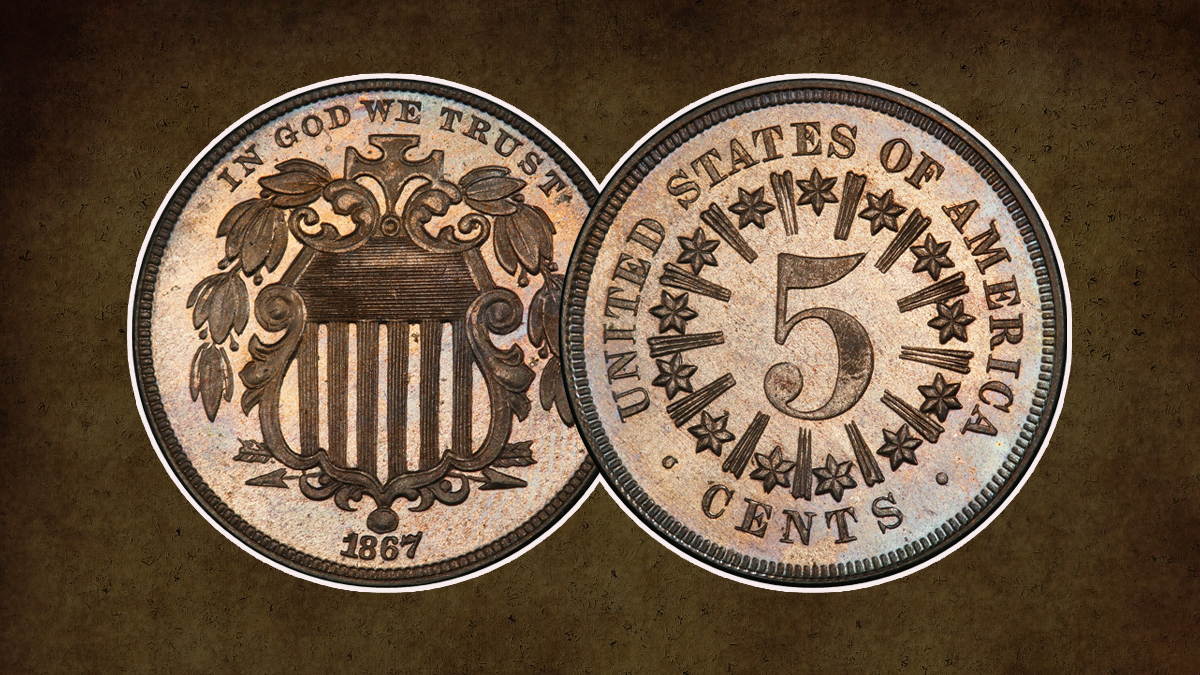
The fascinating variation of the 1867 Shield Nickel is a collector’s dream come true. The having rays reverse and the no rays reverse are the two main circulation variations that have been introduced this year. Also, proof coins have a third reverse with an unique letter and star arrangement. Notably, 1868, ’69, and ’70 Shield Nickels have similar variations.
Less than 7% of the mintage is the 1867 with-rays subtype, presenting a unique rarity. Because of its minor scarcity, collectors often consider it to be an interesting addition, even if it is more valuable than the 1866 edition. The coin’s quality had been enhanced by removing rays that attempted to fix striking problems. However, because of the brief die life during manufacturing, it is still hard to find a beautiful 1867 5¢ with rays coin with good shine and eye attraction.
History of 1867 Shield Nickel
The Act of May 16, 1866, authorized a new five-cent coin made of 25% nickel and 75% copper. This led to the unusual situation of having two coins of the same value circulating simultaneously—the new nickel and the silver half dime. Nearly 15 million new nickels were produced in the first year to promote the new coin and due to the availability of nickel and copper, which were cheaper than silver.
The first versions of the new nickel had rays on the reverse, between the stars surrounding the large 5 at the center. Because of the extra force required to strike the nickel alloy, these additional parts led the coinage dies to fail early. To fix this issue, mint officials ordered the removal of the rays in mid-1867, creating two varieties: With Rays and No Rays. Despite this change, striking problems persisted, resulting in coins with inconsistent strikes and many die cracks.
The Shield Nickel series has no very common dates, but the Proof-only 1877 and 1878 can be difficult to find and demand a high price. The low-mintage 1880 Nickel is always a collector favorite.
Proofs of most dates are readily available, but the 1867 With Rays Proof is very rare. It can be challenging to distinguish between proof-like circulation strikes and true proofs, especially for dates in the late 1870s and those from the 1880s.
Interesting varieties have a big repunched date in 1866, the Open and Close 3’s of 1873, 1879/8, and 1883/2. In 1867, there were two major circulation varieties: the With Rays reverse and the No Rays reverse. In proof coins, there is a third reverse with no rays but a different arrangement of letters and stars.
In addition to 1867, multiple reverses can be found on Shield Nickels struck in 1868, 1869, and 1870. The 1867 With Rays subtype accounts for less than 7% of the five-cent pieces struck that year, with the No Rays subtype making up about 93%. Most type collectors choose the 1866 as an example of the With Rays subtype, but the 1867 With Rays might be a better value due to its relative scarcity.
The rays were removed to improve striking characteristics and to prolong die life, which was very low at only 15,000-20,000 strikes per die. As a result, finding an attractive 1867 5¢ With Ray’s coin with good luster, eye appeal, and an acceptable strike can be difficult.
Coin Specifications: Shield Nickels, With Rays
- Years of Issue: 1867-1883
- Mintage (Circulation):
- High: 14,742,500 (1866)
- Low: 2,019,000 (1867)
- Mintage (Proof):
- High: 500 (1866)
- Low: 75, estimated (1867)
- Alloy: 75% nickel, 25% copper
- Weight: 5.0 g
- Diameter: 20.5 mm
- Edge: Plain
- Obverse Designer: James Barton Longacre
- Reverse Designer: James Barton Longacre
Design
Obverse:
The edges of both sides of the Shield nickel are covered in dentils. None of them show a mint mark because they were all struck at the Philadelphia Mint. The date is centered at the bottom of the obverse, and it has the phrase “In God We Trust” throughout the top border of the field.
A covered shield is in the center and is crowned by a symbolic cross that is above and in front of two crossed arrows at the bottom. The cross can be recognized as the cross of the Order of Calatrava, an ancient Spanish military/religious order, though its identity remains over debate.
Reverse:
On one side of the coin, “United States of America” is written around little more than half of the periphery, and “Cents” is written at the bottom. There are two exactly spaced dots on both sides. The main focus is a big number five, around which thirteen six-point stars and thirteen rays alternatively radiate to form an encircling wreath that sits between the five and the text along the rim. The center dot on the proof of 1866 coins is visible from both sides.
Edge:
The Shield nickel edge with Rays is simple or smooth, without reeding or edge lettering.
Rarity and Condition:
The 1867 Shield Nickel is notable for its two major circulation varieties: with rays reverse and no rays reverse. In proof coins, a third reverse without rays but with a different arrangement of letters and stars exists. This year, along with 1868, 1869, and 1870, exhibits two different reverses.
The with-rays subtype of 1867 is relatively rare, accounting for less than 7% of the total mintage, while the more common no-stars subtype makes up approximately 93%. Striking difficulties led to the removal of rays to enhance coin quality, with the production capacity limited to 15,000-20,000 strikes per die. As a result, finding an attractive 1867 Shield Nickel with rays, characterized by good luster, eye appeal, and an acceptable strike, can be challenging.
Value 1867 Shield Nickel
In Average Circulated (AC) condition, an 1867 Shield Nickel is typically valued around $30.00. However, the value can significantly increase for coins in certified mint state (MS+) condition, potentially fetching as much as $3,600 at auction. It’s important to note that these prices may vary depending on factors such as rarity, condition, and certification by reputable coin grading companies.
Also Read – 1880 Shield Nickel: A Complete Guide
Conclusion:
The 1867 Shield Nickel is important in history being the first five-cent piece with nickel work in the entire nation. It has two important circulation variations and unique design features. Prices can vary from about $30.00 in Average Circulated quality to as much as $3,600 in certified mint state condition, representing its rarity, condition, and struck difficulties. However, based on elements like condition, rarity, and certification from reputable coin grading organizations, these coins’ real worth may differ.
